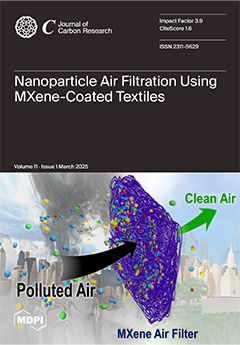This research explores the synthesis and application of carbon-based adsorbents derived from olive stones and almond shells as low-cost biomass precursors through carbonization at 600 °C combined with chemical activation using KOH, H
3PO
4, and ZnCl
2 with carbon/activating agent
[...] Read more.
This research explores the synthesis and application of carbon-based adsorbents derived from olive stones and almond shells as low-cost biomass precursors through carbonization at 600 °C combined with chemical activation using KOH, H
3PO
4, and ZnCl
2 with carbon/activating agent (C/A) ratios of 1:2 and 1:4 (
w/
w) at 850 °C for the removal of Cu
2+ and Pb
2+ ions from aqueous solutions. The carbons produced were characterized using different techniques including SEM-EDX, FTIR, XRD, BET analysis, CHNS elemental analysis, and point of zero charge determination. Batch-mode adsorption experiments were carried out at adsorbent doses of 2 and 5 g L
−1, initial metal concentrations of 100 and 500 mg L
−1, and natural pH (around 5) with agitation at 350 rpm and 25 °C for 24 h. KOH-activated carbons, especially at a 1:4 (
w/
w) ratio, exhibited superior adsorption performance mainly due to their favorable surface characteristics and functionalities. Pb
2+ was entirely removed (100%) at the highest initial concentration of 500 mg L
−1 and an adsorbent dosage of 5 g L
−1, while for Cu
2+, the maximum adsorption efficiency was 86.29% at an initial concentration of 100 mg L
−1 and a dosage of 2 g L
−1. The results of this study will help advance knowledge in the design and optimization of adsorption processes for heavy metal removal, benefiting industries seeking green technologies to mitigate environmental pollution.
Full article





